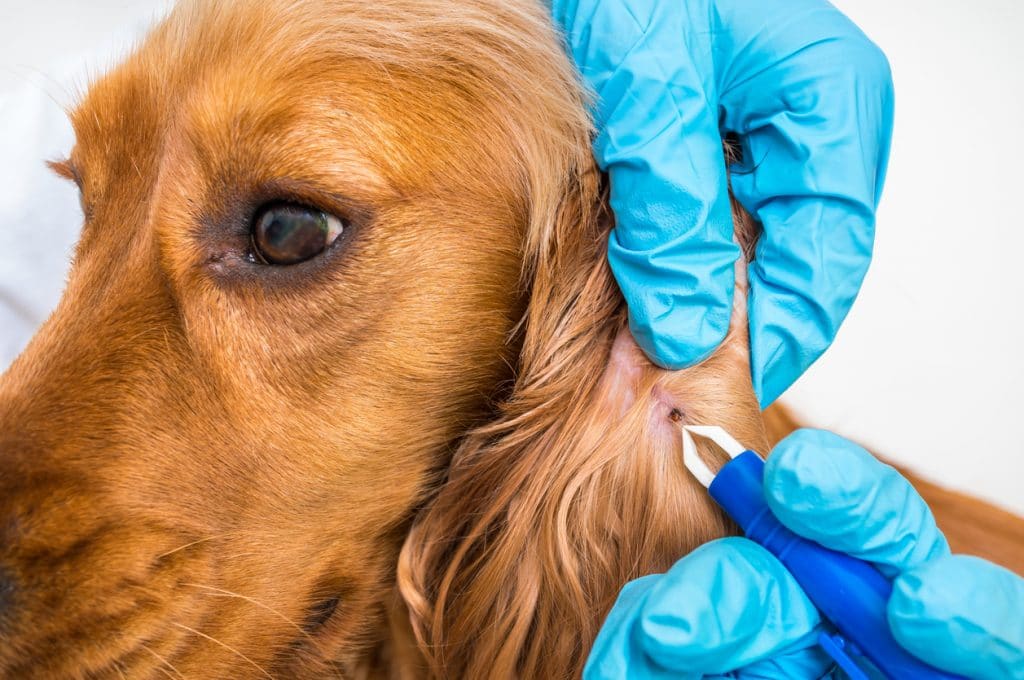- Not a substitute for professional veterinary help.
Enjoying the great outdoors with your pet is something that should be enjoyable and fun. Unfortunately, tick-borne diseases are always a risk, especially as the weather warms and we spend more time outside with our pets. This means it’s of the utmost importance to keep your dog safe from ticks and their transmissible illnesses.
While humans are susceptible to tick bites as well, dogs are at high risk due to being lower to the ground when they walk in the woods or through high grasses.
Ticks transmit many parasitic, bacterial, viral and other diseases, such as Lyme disease, among animals and from animals to humans. The salivary secretions of some female ticks are toxic and can produce a syndrome known as “tick paralysis” in people and animals.
Tick exposure can lead to a variety of diseases. In addition to Lyme disease and Rocky Mountain spotted fever, tick exposure may transmit diseases including: anaplasmosis, babesiosis, ehrlichiosis, and mycoplasmosis. Read on to find out about symptoms and strategies for avoiding and removing ticks. The next time you’re preparing for a hike with your dog, don’t forget about tick prevention!

iStock/PK-Photos
How do I know my pet has ticks?
According to Dr. Rebecca Greenstein, Rover panelist and Chief Veterinarian at Kleinburg Veterinary Hospital, it is always a good idea to manually check your dog for ticks after spending time outdoors.
“Ticks are often found in wooded areas, but that’s certainly not the only place,” says Dr. Greenstein. “You can find them almost anywhere outside. My staff and I are often surprised by the places where dogs are exposed. If your dog does have a tick, it’s also time to check the other members of your household, since there is a strong likelihood that you might be exposed, too.”
Tick exposure can lead to Lyme disease and other illnesses. Common symptoms in a canine may include:
- Swollen joints, difficulty moving, or paralysis
- Limping
- Severe fatigue
- Fever
- Swollen lymph nodes
- Loss of appetite
- Noticeable change in behavior
“It’s also important to note that some of these symptoms may overlap with much more innocent conditions,” says Dr. Greenstein. “Some dogs may only exhibit minor symptoms or, in some cases, may even be asymptomatic. The best solution is not only thoroughly checking your pet for ticks but to have them routinely screened for Lyme disease as well.”
A dog might not show signs of being bitten right away. In fact, symptoms of a tick-related illness may not appear for 7-21 days, which is why it’s crucial to be proactive about tick prevention.
Even if you find a tick on your dog and remove it right away, it is recommended to contact your vet for a thorough examination of your pet.
How can I prevent ticks from bothering my dog?
When it comes to determining which type of treatment is best for your dog, consulting your veterinarian is key.
“No product has a one-hundred percent accuracy rate, but in this day and age, it’s a no-brainer to have your dog on a monthly tick preventative,” says Dr. Greenstein. “These preventatives can come in different forms, such as topical or chewable, and can help lower the risk of infection.”
Once your vet has determined the best type of tick treatment for your dog, they may recommend one of the following prevention methods:
- Oral Medication: This method helps ensure that a tick biting your dog will bite the dust before transmitting disease.
- Tick Collar: These specially-treated collars emit tick repellent that will ideally kill a tick upon contact.
- Topical Treatments: Similar to the above collars, topical treatments are an alternative to oral medication. They are meant to kill ticks and can vary from sprays to ointments.
Lifestyle, location, and your pet’s specific needs are going to impact the safest and most effective way to prevent the intrusion of these pests.
In addition to cyclical treatments, it is recommended for dogs to receive a Lyme disease vaccination annually.
“If you have a cat, tick prevention will differ,” notes Dr. Greenstein, who advises to never use dog tick preventatives on cats. “Some chemicals in treatments for dogs can be fatal to cats, so it’s always good practice to talk to your vet about all of the pets in your home.”

iStock/andriano_cz
What should I do if I find a tick on my dog?
As a pet parent, it’s good practice to know how to remove ticks from your dog. A tool such as The Tick Patrol Tick Remover can come in handy in the event your dog is exposed and can help ensure the removal of the tick is easy and timely.
The Humane Society recommends the following steps to ensure efficient tick removal:
- Search your dog for ticks. A burrowed tick may cause a swollen and irritated area on your dog’s skin. Make sure to check their ears, face, neck, and paws in addition to their torso.
- Identify the tick. Some of the smallest ticks are no larger than the head of a pin. Ticks are usually brown, black, or tan, and have eight legs.
- Make sure to wear gloves! You want to avoid the tick making contact with your own skin, so always wear gloves when removing a tick from your dog.
- Remove the tick. Using a tick remover, gently press the remover against your pet’s skin near the tick. Slide the notch of the remover under the tick, pulling it free. If using tweezers, grasp the tick as close to your dog’s skin as possible. Pull it out in a straight, steady motion.
- Drop the tick into isopropyl alcohol and note the date. It is ideal to keep the tick in case your vet wants to pursue further testing.
- Wash your hands!
- Make a vet appointment, and monitor your dog for any signs of illness.
- Check other people and pets in your home for ticks. Then, make sure to bathe your pet, comb them with a flea comb, and wash any bedding or blankets.
Check out this step-by-step tick removal video, provided by the Ontario Society for the Prevention of Cruelty to Animals.
What questions should I ask my vet about tick prevention?
With prevention, tick-borne diseases can be avoided. On your next visit to the vet, make sure to come prepared with the following questions:
- What type of tick treatment makes the most sense for my dog? What about a monthly or seasonal preventative?
- Does my dog need a Lyme disease vaccination?
- Is my dog’s tick prevention safe for the other pets living in my household? Are indoor pets vulnerable to ticks?
- What ticks live in my region?
- What do I need to know about visiting a new region or outdoor location with my dog?
- If I find a tick, should I come straight in, or wait for symptoms?
- Does your vet have any preferred tick prevention products?
Summer should be the best time of the year for pet parents to be out with their four-legged friends. With a little planning, you and your dog can safely enjoy the best of the season together.



